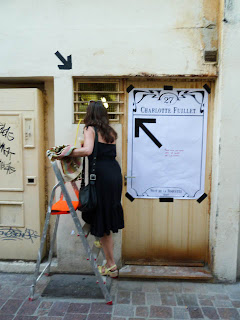With my passion for photobooths and Polaroid cameras, this was surely the theme I was most interested in. And it didn’t disappoint. Following the recent bankruptcy ofthe Polaroid Coporation in 2008, and the recent sale of the Polaroid Collection at Sotheby's, there seemed quite a nostalgia for the instant film and it was honoured in a timely fashion. The Espace Van Gogh had a selection from the Polaroid collection which is held by the Musee de l’Elysee in Lausanne, featuring polaroids by Ansel Adams, Andy Warhol and other big names. As part of the fringe festival, there was a small show in a bar, of polaroids taken using the new film produced by
The Impossible Project, an organisation trying to recreate instant film in a more ecological manner. It was interesting to see the results of their film; very subdued, pastel colours, and still that wonderful eerie feel.(The film is onsale at the
Photographer’s Gallery in London; it’s expensive, but I think it’s worth supporting their enterprise).
The Analogue trail also included a retrospective of the work of Italian photographer Mario Giacomelli, his wonderfully high contrast black and white images still full of life after all these years. Also included was the collection of Marin Karvitz, the tycoon behind the French cinema chain MK2. Typically very cinematic in feel, the photographers in his collection ranged from film directors such as Abbas Kiriiostami and Chris Marker, to installationists such as Annette Messager and Christian Boltanski, to classic black ad white photographs by Doisneau, Sugimoto, and Kertesz.
But THE highlight of the festival was an exhibition entitled Shoot! This was based on an old fairground game, in which the punter shoots at a target, and if he gets the bullseye, his photograph gets taken. A German woman, Ria Van Dyke, has played this game each year since 1936 (with a break between 1939 – 1945, for obvious reasons). She would give herself 10 shots, and every year she got her picture. The result is a record through time – of trends, fashions, and photographic technology, as polaroids come in in the early 60’s. And throughout all this time she doesn’t change (apart from the signs of age)… her posture remains exactly the same. A wonderful series of portraits which was collected by Erik Kessels and made into a book, perhaps a little prematurely as the woman is still alive and could have another go (although sadly in 2009 she missed her target in her allotted 10 shots).
 Ria van Dyke in later years. Interestingly, with the advance in technology there is the demise in quality of the print.
Ria van Dyke in later years. Interestingly, with the advance in technology there is the demise in quality of the print.
The rest of the exhibition showed a collection of artists who were inspired by this idea of shooting yourself (which is essentially what is happening here). Swiss artist Rudlof Steiner set up a row of pinhole cameras (without the hole), only to fire at them in order to make the hole and expose the negative. The final video installation by Christian Marclay was also amazing; a screen on each of 4 walls, each showing snippets from films of gangsters loading their guns. The build up is slow, the sounds very loud, you hear (before you see because it’s hard to tell which screen is going to show something next) the bullets going into the guns, the cocking of the safety catch… this builds up and builds up until BANG! You are caught in the crossfire as the villains shoot to the opposite screen. Hard to explain, and I hope you get a sort of sense of it… one of the only video art pieces I’ve seen which I've been really engaged with.
 To the left, is a model of what the set up in the fairground would have looked like. A 5x4 camera! The mind boggles... there must have been a little man in the back quickly developing the print and printing it. To the right, an example of Rudolf Steiner's pinhole work.
To the left, is a model of what the set up in the fairground would have looked like. A 5x4 camera! The mind boggles... there must have been a little man in the back quickly developing the print and printing it. To the right, an example of Rudolf Steiner's pinhole work.
And then, to culminate this wonderful exhibition, there was a chance at playing the Shooting game yourself. I had 4 tries… and managed it on the final one. Not sure how, as there is no hole in the bullseye of my target – a fluke ricochet no doubt. But I’m happy – I never knew I could look so concentrated.
 I think the best thing about this part of the festival for me was the projections. Often curated to a theme (such as work, or desire) each projection shows the work of perhaps 10 photographers, accompanied to music (which is often live). It is a chance for emerging photographers to be involved and seen, and there was some very good work. (I had written down some names but they were in my notebook which was in my bag which got stolen last weekend – bummer)
I think the best thing about this part of the festival for me was the projections. Often curated to a theme (such as work, or desire) each projection shows the work of perhaps 10 photographers, accompanied to music (which is often live). It is a chance for emerging photographers to be involved and seen, and there was some very good work. (I had written down some names but they were in my notebook which was in my bag which got stolen last weekend – bummer)













